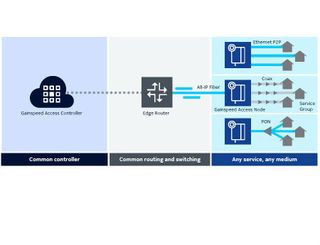Cable-Tec Expo: Nokia Puts Gainspeed Buy to Work

Roughly two months after salting away its acquisition of Gainspeed, Nokia has unveiled a virtualized version of the Converged Cable Access Platform (CCAP) that spans support for HFC- and PON-delivered services and applies a vision for the industry’s all-IP future.
Nokia timed the announcement with this week's SCTE/ISBE Cable-Tec Expo in Philadelphia.
Get complete coverage of Cable-Tec Expo 2016
Nokia’s vCCAP, which factors in a shift toward energy- and bandwidth-efficient distributed access architectures that push transport electronics toward the edge of the network, is comprised of a mix of products that incudes elements acquired via Gainspeed and developed previously by Nokia. They include the Gainspeed-branded, software-driven Access Controller, Video Engine, and access nodes that support DOCSIS 3.1 and DOCSIS 3.1 (the SC-2D), and another access node that supports 10G EPON (the SF-4X). Nokia said the new solution will be commercially available later this year, with the SF-4X slated for launch in early 2017.
Currently in a number of customer lab and field trials across North America and Europe, the new unified cable access solution will be available commercially later this year with the SF-4X following in early 2017.
“We’ve been aggressively working together and integrating Gainspeed into the Nokia family, both the people and the products,” Jeff White, head of cable strategy and business development at Nokia, who joined the company from Gainspeed following the acquisition,” said, noting that the system is capable of managing and orchestrating not just CCAPs but other types of media and devices on the network and accelerate the deployment of new services.
While remote PHY architectures are becoming popular among some vendor products, Nokia’s approach is to distribute both the MAC and PHY elements. The platform’s Video Engine will help MSOs adapt their video services to the new Ethernet-powered network while keeping their legacy components intact.
Multichannel Newsletter
The smarter way to stay on top of the multichannel video marketplace. Sign up below.
White said Nokia’s angle will help MSOs reduce power and space requirements at headends that are outfitted with centralized, “big iron” CCAP chassis as capacity demands continue to rise. It can also prolong the need for MSOs to pull fiber to the premises, or at least put them in position to do so further down the road.
“As capacity grows at a fast clip, doubling every two years, they [cable operators] are literally running out of space in the headends,” White said.
Nokia will be using the new vCCAP product line to compete with cable access rivals such as Arris, Cisco Systems, Casa Systems, Harmonic and Huawei.
“The virtual CCAP is a legitimate phenomenon,” Jeff Heynen, consulting director and analyst at SNL Kagan, said in an interview for a feature story on this topic that will be featured online and in Cable-Tec Expo dailies that will be distributed this week by Multichannel News (link to preview edition). “I think this is an opportunity with vendors without share to get some traction.”
White said Nokia is pursuing a wide range of deployment scenarios, including those specific to multiple-dwelling units (MDUs), as operators consider alternative architectures as they split nodes and go “fiber-deep,” and even putting its new platform side-by-side with legacy platforms. Yet another option, he said, is the notion of removing an existing CCAP and converting headends and hubs to virtual and distributed systems.
Nokia has not announced any specific trials or deployments with MSOs, but said it is in multiple customer lab and field trials with “major” operators in North America and Europe.
When the Nokia-Gainspeed deal was announced, Comcast, Liberty Global and WideOpenWest all praised the acquisition, with WOW noting that it was testing Gainspeed’s platform and “preparing for deployment.”
Gainspeed, based in California, was founded in 2012 by Shlomo Rakib, a DOCSIS pioneer and co-founder of Terayon Communication Systems (sold to Motorola in 2007). Nokiaannounced its agreement to acquire Gainspeed on June 9.
